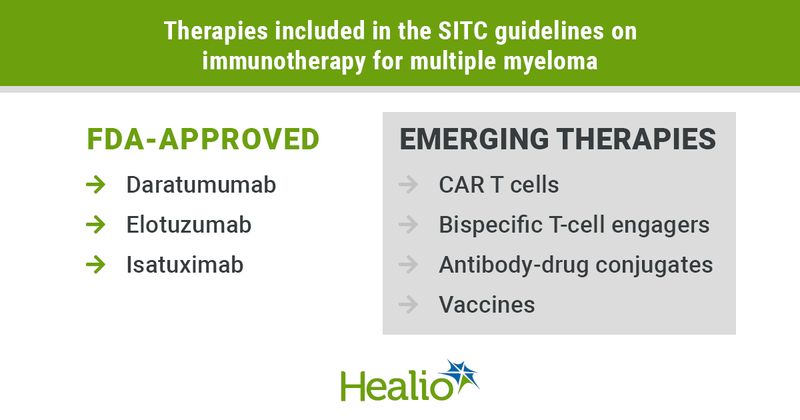New guideline for multiple myeloma to aid clinicians with limited immunotherapy experience
The Society for Immunotherapy of Cancer issued a clinical practice guideline on the use of immunotherapy for the treatment of multiple myeloma.
The guideline, published in Journal for ImmunoTherapy of Cancer and freely available via the society’s website, outlines key areas practitioners should consider along with expert, evidence-based recommendations.

Healio spoke with co-chairs of the guideline panel to gain greater insight into the issues they address and how they should be applied in clinical practice.
Addressing a knowledge gap
The Society for Immunotherapy of Cancer (SITC) guideline provides an overview of each immunotherapy to be considered for multiple myeloma, including both FDA-approved and emerging therapies currently in clinical trials. Recommendations are provided for each therapy in areas such as patient selection, dosing and administration, specific considerations unique to the therapy and treatment-related toxicities.
The major motivation behind the guideline’s development was to address an unmet need in SITC guidance in an area with rapidly developing treatment options, according to expert panel members.

“Although immunotherapies may offer dramatically improved outcomes for patients with multiple myeloma, these new agents differ markedly from conventional cancer treatments in terms of their administration, toxicity profiles and patterns of disease response,” Nina Shah, MD, associate professor of clinical medicine at University of California, San Francisco, and co-chair of the SITC Multiple Myeloma Immunotherapy Guideline Expert Panel, told Healio. “With many of the advances in cancer immunotherapy occurring within the last several years, a large knowledge gap persists concerning familiarity and utilization of immunotherapies, as well as the management of immune-related adverse events.”
SITC first published a consensus statement on the use of immunotherapies for hematologic malignancies in 2016, according to Madhav Dhodapkar, MD, professor and director of the Center for Cancer Immunology at Winship Cancer Institute of Emory University and co-chair of the guideline expert panel.
The initial consensus statement included recommendations on acute leukemia, lymphoma and multiple myeloma.

“In the intervening years, immunotherapy has increasingly become a cornerstone of care for hematologic malignancies, including multiple myeloma,” Dhodapkar told Healio.
The volume of advances in the field of immunotherapy prompted SITC to issue standalone guidelines for each disease, he added. The guideline on multiple myeloma is the first in the series.
“With an ever-growing number of immunotherapeutic agents that have been approved or are in the final stages of clinical development, SITC identified an opportunity to bring together leading experts to utilize their experience along with evidence from the published literature as the basis for a clinical practice guideline on immunotherapy for multiple myeloma,” Shah added.
Assisting clinicians
The guideline has multifaceted uses depending on one’s familiarity with immunotherapies.
“The primary audience for these guidelines is hematologists and oncologists who may have limited experience in the administration of immunotherapies, such as practitioners working in smaller hospitals or in community settings,” Dhodapkar said.
The goal of the guideline, he added, is to enhance the clinical decision-making process while providing patients with the best care possible.
Advanced practice providers and oncology nurses will find the guideline useful for information on treatment-related toxicities and administration of immunotherapies, Dhodapkar said.
Shah added that the guideline can be used by clinicians when considering immunotherapy combination regimens for first-line treatment among transplant-eligible and -ineligible patients, as well as in treatment selection for patients with relapsed or refractory multiple myeloma.
Applying guidelines in practice
With the role of immunotherapy in cancer treatment continuing to expand, guidelines such as this will be necessary to provide clinicians with a quick reference on the current state of the science, according to expert panel members. The pace of innovation will continue given the number of emerging therapies in development, Shah said.
“Immunotherapy is currently playing a pivotal role in the treatment of multiple myeloma, with deep and durable responses leading to better outcomes for patients when administered in both first-line and relapsed and refractory settings,” Shah told Healio. “Additionally, demonstrated safety and efficacy data in advanced trials for emerging multiple myeloma treatment modalities, such as CAR T-cell therapies and bispecific antibodies, indicate that additional immunotherapeutic options are on the horizon that may further advance patient care.”
Shah said practitioners’ use of evidence-based guidelines has been repeatedly demonstrated to improve patient care, and she believes the SITC guideline on multiple myeloma will maintain this trend.
“Guidelines have the potential to reduce morbidity and mortality and improve quality of life, as well as improve the consistency of care. In some circumstances, guidelines may also assist in justifying insurance reimbursements for interventions or diagnostic tests, helping patients access care without undue financial burden,” she said. “The use of guidelines has time and again been demonstrated to be associated with improved outcomes for patients, and these are no exception.”
For more information:
Madhav Dhodapkar, MD, can be reached at madhav.v.dhodapkar@emory.edu.
Nina Shah, MD, can be reached at nina.shah@ucsf.edu.

